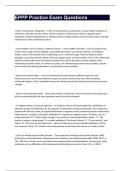Exam (elaborations)
EPPP Practice Exam Questions
EPPP Practice Exam Questions J. Berry acculturation, integration - J. Barry conceptualizes acculturation as many models existing on a continuum, with the minority culture and the majority or mainstream culture at opposite poles. Integration would be displayed by an individual who has high ret...
[Show more]



